Motorized Paddle Boards: A Complete Guide

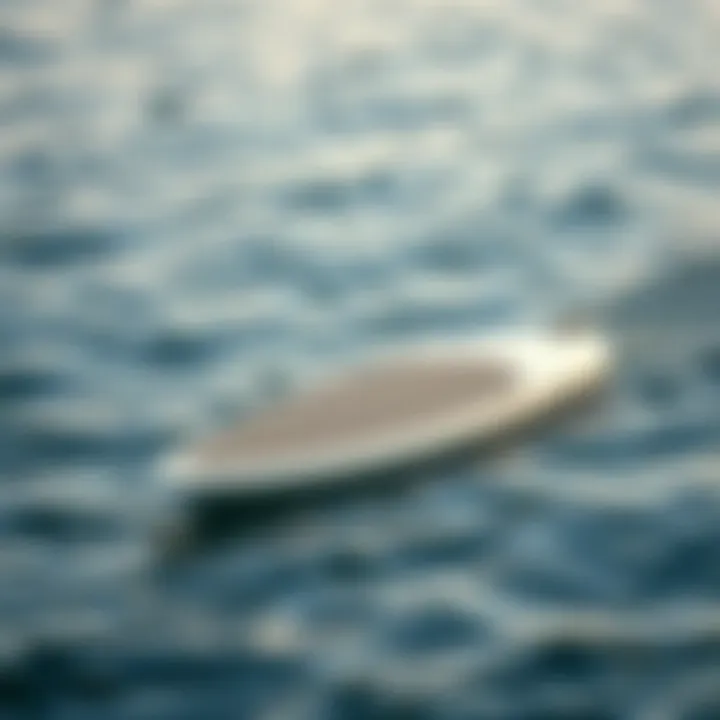
Intro
Motorized paddle boards are reshaping how enthusiasts engage with water sports. With advancements in technology and design, these boards offer a unique blend of traditional paddling and modern convenience, allowing for an exhilarating experience on the water. Understanding both the benefits and operations of motorized boards can open up new opportunities for exploration, whether you’re cruising along a calm lake or tackling choppy waves.
This guide aims to break down the essential features of motorized paddle boards, diving into their construction, the technology that powers them, and how they differ from conventional boards. For both seasoned riders and newcomers alike, gaining knowledge about this innovative equipment can elevate one’s overall experience. With the right information, you can make informed choices that enhance your time spent on the water.
The following sections will illuminate key surfing techniques for both beginners and experienced adventurers, establish criteria for surfboard selection, and touch upon maintenance and care. By the end, you’ll be well-equipped not only to navigate the waters smoothly but also to embrace the future of paddle boarding with confidence.
Preface to Motorized Paddle Boards
Motorized paddle boards have become a remarkable innovation in the world of water sports. They stand at the intersection of traditional paddle boarding and modern technological advancements. For outdoor enthusiasts and athletes alike, understanding these boards is not just about navigating the waters; it's about enhancing the experience on the water, merging skills with convenience.
Definition and Overview
A motorized paddle board, quite simply, is a stand-up paddle board equipped with an electric motor. This addition transforms the vessel from a manual to a powered mode of transportation. Riders can cruise across waterways effortlessly, leaving the paddle strokes behind in favor of a throttle. Despite the surface simplicity, the technology embedded in these boards is quite sophisticated, utilizing brushless motors and lithium batteries. These advancements allow for longer rides and faster speeds, making it easier for amateurs and pros to enjoy longer excursions.
The muscle power that defines traditional paddle boarding often requires stamina and skill. With motorized paddle boards, users can easily adjust their rhythms, focusing on the scenery rather than the effort involved. Such accessibility makes it a favorite for those who might struggle with conventional paddling, such as beginners or individuals with physical limitations.
Historical Development
The evolution of motorized paddle boards didn’t happen overnight. Their roots can be traced back to the rise of water sports in the 20th century. During the early days, paddle boards relied solely on human strength to navigate and exercise. However, as technology progressed, so did the designs and motivations behind these boards.
Initial experiments with motorizing surfboards and paddle boards occurred sporadically in the late 20th century. Yet it wasn't until the early 2000s that entrepreneurs began devising practical solutions, integrating motors into paddle boards effectively. Early models were primarily targeted at surf enthusiasts seeking an edge in waves. But as user interest expanded, manufacturers realized the potential for leisurely cruising on lakes and rivers.
The real game changer came with the miniaturization of battery technology. Lithium-ion batteries became lighter and more efficient, allowing for longer outings without compromising on weight. By the 2010s, a variety of brands emerged, each vying for attention by delivering unique features such as wireless controls, customizable speed settings, and enhanced stability.
The contemporary motorized paddle board can cater to an array of preferences and environments, reflecting the continuous growth and acceptance of such technology in the water sports community. The blend of tradition and technology exemplifies a shift, attracting a broader audience.
"The thrill of gliding over the water, powered by innovation, invites everyone, from the curious newcomer to the seasoned wave-rider, to engage with nature in a whole new way."
Understanding the inception and functionality of motorized paddle boards helps ground enthusiasts in both their heritage and its future potential. As we dive deeper into the specifics of these boards, it becomes clear that they aren't just a trend; they represent a significant shift in how we engage with the waterways.
Component Breakdown of Motorized Paddle Boards
Understanding the components of motorized paddle boards plays a key role in appreciating their functionality and advantages. Each part, from construction materials to motor systems, contributes significantly to the performance and user experience of these boards. Whether a newbie or a seasoned paddle boarder, knowing what's under the hood can enhance your choice and usage, ultimately ensuring that you select a board that meets your adventure needs. Below, we break down the main elements of motorized paddle boards, providing depth and clarity for buyers and users alike.
Board Construction Materials
The materials used in the construction of motorized paddle boards are paramount for performance, durability, and user comfort. Typically, paddle boards are made from materials such as epoxy resin, fiberglass, or even inflatable PVC for easy transport.
- Epoxy Resin: Often seen in high-end paddle boards, epoxy offers great strength and lightweight characteristics, which enhances maneuverability on the water.
- Fiberglass: This traditional material provides excellent stiffness and durability but can be a bit heavy. Boards made from fiberglass are often designed for experienced users who value performance over portability.
- Inflatable PVC: These boards are growing in popularity due to their ease of transport. They are puncture-resistant, lightweight, and can be deflated to fit into a backpack, making them an ideal choice for travelers. However, they may not provide the same level of efficiency in terms of speed as hard boards.
Choosing the right material often depends on the intended use and preferences of the user. Some people prefer the stability of a heavy-duty board for cruising, while others might seek the portability of lighter, inflatable options.
Motor and Battery Systems
The heart of motorized paddle boards lies in their motor and battery systems. Selecting a board with the right motor power can make or break your experience on the water.
- Motor Power: Most boards on the market feature brushless electric motors that range from 400 to 1500 watts. Higher wattage generally translates to higher speeds, but the weight and size of the battery must also be factored in. For instance, a 1000-watt motor can propel you at considerable speeds as long as it's paired with an adequately sized battery.
- Battery Capacity: Battery capacity is often measured in amp-hours (Ah). A board with a higher Ah rating allows for longer usage between charges. Typically, a range of 10-20Ah is seen in consumer models. Users planning extended outings should pay close attention to this aspect to ensure they don’t get stranded mid-paddle.
- Charging Time: Charging efficiency also varies between brands. While some batteries take as little as 4 hours to recharge, others might require up to 8 hours. It's wise to consider how much downtime you may have between sessions.
Understanding the motor and battery configurations is critical not just for selecting a board, but also for managing energy consumption effectively while you enjoy the waters.
Control Interfaces and Features
Control interfaces in motorized paddle boards have come a long way. Modern boards often include intuitive setups that help the rider manage speed and battery life effectively.
- Remote Controls: Many boards come with handheld remote controls that allow users to adjust speed seamlessly while paddling. This feature is particularly handy for those who want to switch between manual and motorized power fluidly.
- Built-in Displays: Some more advanced models feature built-in displays that provide real-time data regarding speed, battery life, and distance traveled. This information can be incredibly useful for longer excursions where battery management is essential.
- Safety Features: Many manufacturers are now including safety mechanisms, such as automatic shut-off when the board is not in motion for a specified time, to prevent accidents and conserve battery when you're taking a break.
Having a board that embraces the latest technology enhances not just the experience but also prioritizes safety and convenience in the water.
In summary, every component of a motorized paddle board plays an integral role in shaping its overall functionality. Knowing about these elements will aid enthusiasts in making informed choices, paving the way for a more enjoyable aquatic adventure.
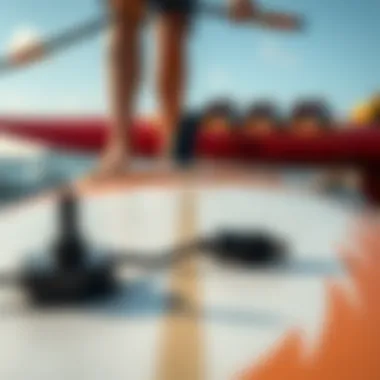
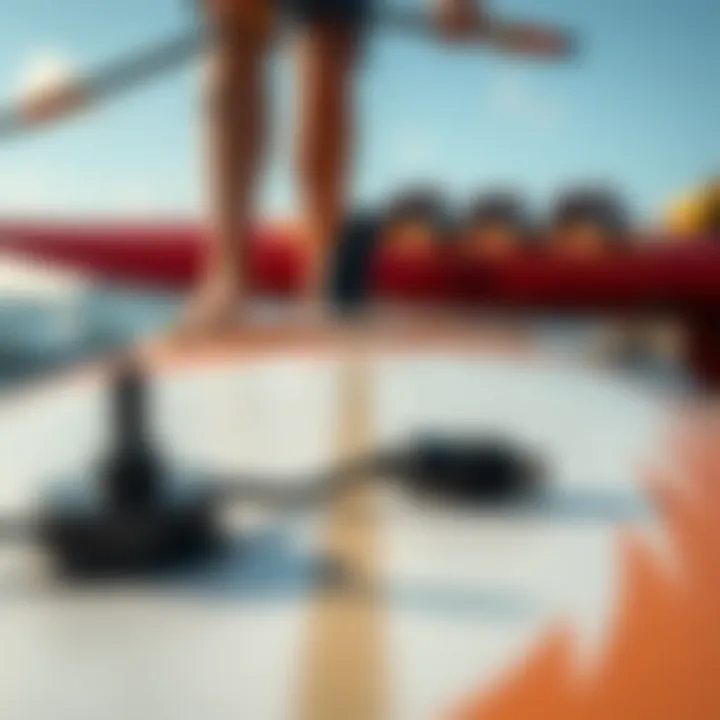
Advantages of Using Motorized Paddle Boards
Motorized paddle boards stand out in the realm of water sports, providing unique benefits that appeal to a wide audience. In this section, we delve into the various advantages that these boards offer, emphasizing why they’re becoming the go-to choice for many enthusiasts. From saving time to broadening accessibility, motorized electric boards pack a punch in terms of innovations and improvements over traditional paddling.
Enhanced Speed and Efficiency
One of the most significant advantages of motorized paddle boards is their enhanced speed. Imagine skimming across the water, leaving the paddle behind, with the wind in your hair. These boards often reach speeds that far exceed those of conventional types. For example, while a typical paddler might cruise at around 3 to 5 miles per hour, many motorized paddle boards can effortlessly push to speeds of up to 15 miles per hour. This makes them perfect for covering larger distances in shorter intervals—ideal for day-trippers and those eager to explore beyond the shoreline.
Additionally, efficiency plays a role here. The use of a motor means lesser energy exertion is required from the rider. Paddling for hours while trying to make headway can be tiring and may discourage many. With a motorized model, enthusiasts can enjoy extended water outings with minimal physical effort. Going from point A to B smoothly means more time soaking up nature and less time worn out from paddling.
Reduced Physical Strain
Physical strain is a familiar foe to all who partake in paddling—whether you're a seasoned pro or a casual weekend warrior. Motorized paddle boards alleviate this concern greatly. This aspect becomes particularly appealing for diverse groups. Seniors, individuals recovering from injuries, or those who simply want a less strenuous outing can all benefit from the ease of use that these boards provide.
Rather than relying on your arms and core strength, you can navigate waters with the touch of a button. With just a flick of the throttle, you glide across, minimizing the impact on your muscles and joints. Riding a motorized paddle board often feels akin to sailing: journeys become about the experience of being on the water rather than the physical challenges that come with traditional paddle boards.
Accessibility for All Skill Levels
Motorized paddle boards serve as a bridge into the extraordinary world of paddle boarding for those intimidated by the demands of traditional boards. Whether it's a child, a novice, or someone who’s never set foot on a board before, getting started is much more manageable. The presence of a motor creates an inviting entry point, calming fears around balance and paddling techniques.
In some locations, these boards even open doors for those who may have disabilities that limit their ability to use standard boards. The feeling of riding across the water, independent and in control, can be an empowering experience. The added support of a motor helps dissolve barriers that might have previously kept people from enjoying water sports.
These benefits mark motorized paddle boards as not just recreational tools, but versatile options that promote inclusivity in outdoor activities. As more folks wish to join in excursions and explore environments, this access encourages a communal feel and brings families and friends together in nature.
Motorized paddle boards are not just a trend; they represent a shift towards an inclusive water sports culture, enabling a variety of adventurers to get on the water together.
In summary, the advantages of motorized paddle boards cannot be overstated. From their speed and efficiency to reducing physical strain and promoting accessibility, they are designed to enhance the overall experience of paddle boarding. As advancements in technology continue to evolve, so too do the opportunities for enjoying water activities in a way that suits one's style and abilities.
For more insights, check resources like Wikipedia and Britannica for detailed understanding.
Comparative Analysis with Traditional Paddle Boards
In the growing world of water sports, motorized paddle boards are carving out their niche. Comparing them with traditional paddle boards provides valuable insight into performance, experience, and cost considerations. This analysis helps users make informed decisions based on their individual needs and paddling habits.
Performance Metrics
When it comes to performance, motorized paddle boards have an edge over their traditional counterparts. For starters, the motor provides an extra boost, enabling riders to achieve higher speeds and cover greater distances with less effort.
Consider the following factors that often come into discussion:
- Speed: Traditional boards typically rely purely on human power, which can limit speed significantly. Motorized boards can hit speeds of up to 20 mph, making them ideal for those looking to race or explore larger bodies of water.
- Stability: Motorized boards often come with enhanced stability due to their construction, offering a smoother ride even at higher speeds.
- Adaptability: With the ability to switch between human and motorized power, users can cater their experience depending on energy levels or weather conditions.
User Experience and Learning Curves
One undeniable aspect of using a motorized paddle board is the change in the user experience. Beginners might feel that the learning curve is greatly reduced. Why? It's simple—everyone can hop on and feel a thrill without needing extensive training. Traditional paddle boarding can sometimes feel daunting to novices, as it requires good balance and stamina. In contrast, here’s what users can expect with motorized options:
- Immediate Empowerment: Many beginners find that they can keep up with more experienced paddlers or explore larger areas without the tiring process of paddling.
- Accessible Exploration: Users can access locations that were previously challenging. Right from tracking along the shorelines to idle drifting while enjoying a picnic on the water, motorized boards can take you there with ease.
- Learning for the Future: For those who still desire to master the art of paddling, the capability to switch off the motor allows for a gradual learning process. Users can build their confidence before fully engaging in manual paddling.
Cost Considerations
The financial aspect of choosing between these two types of boards can't be ignored. While motorized boards often come with a higher initial cost, their benefits might balance out the investment. Here’s a clearer comparison:
- Initial Investment: High-quality motorized boards can range from $1,000 to upwards of $3,000, while traditional boards typically vary from $300 to $1,500, depending on materials and brands.
- Maintenance Costs: Motorized boards may need more upkeep, especially concerning battery management and electrical components. Traditional paddle boards generally have fewer maintenance needs.
- Value over Time: By achieving better performance and accessibility, motorized boards can potentially yield a better experience overall, making them worth their weight in gold, particularly for serious enthusiasts.
"The choice often narrows down to what you want out of your paddling journey. If speed and exploration fuel your desire, a motorized paddle board could be a worthy investment."
Safety Considerations for Motorized Paddle Boarding
Engaging in motorized paddle boarding can usher in thrilling experiences on the water, but safety must be at the forefront of any adventure. As with any water sport, understanding safety measures can be the difference between a memorable day of fun and a potential mishap. This section delves into the essential gear every paddler should have and the local regulations that govern paddle boarding activities, ensuring that enthusiasts have all the tools they need for safe enjoyment.
Essential Safety Gear


It’s crucial to equip oneself with the right safety gear before hitting the water. Below are some fundamental items that every motorized paddle boarder should consider:
- Life Jacket (PFD): Wearing a properly fitted personal flotation device is non-negotiable and can significantly increase your chances of staying safe. The U.S. Coast Guard categorizes different types of PFDs, so it’s wise to select one that suits your paddle boarding needs.
- Leash: A leash connects you to your board, preventing it from drifting away if you fall off. This is particularly important if you are venturing into deeper waters.
- Whistle: An inexpensive yet critical item, a whistle can aid in signaling for help if necessary. Consider it a small yet powerful tool in your safety arsenal.
- Sunscreen: Though not a gear in the traditional sense, don’t underestimate the importance of protection from sunburn or even heatstroke during long paddles. Choose a waterproof and high-SPF sunscreen.
- First Aid Kit: Always have a basic first aid kit onboard. Include band-aids, antiseptic wipes, and any personal medications. It pays to be prepared for the unexpected.
- Navigation Tools: If exploring unfamiliar waters, having tools like a GPS or a waterproof map can help in avoiding dangerous areas and ensuring a safe return.
Each item acts as a safety net, allowing for a favorable atmosphere while enjoying your time on the water. Remember, these are not just accessories; they are lifesavers.
Understanding Local Regulations
Before launching your motorized paddle board, being aware of local regulations is essential to follow the law and maintain safety. Regulations can vary significantly from one body of water to another and may include:
- Registration Requirements: Some states mandate that motorized watercraft, including paddle boards, are registered. Ensure you check local laws and adhere to them to avoid fines or confiscation.
- Speed Limits: Open waterways might have designated speed zones, especially in areas frequented by swimmers or kayakers. Adhering to these limits can prevent collisions and protect the more vulnerable users of the water.
- Zones of Operation: Some lakes or rivers may have specific areas where motorized devices are prohibited. Understand the waterways you intend to explore.
- Wildlife Protection Rules: If navigating through national parks or protected areas, be mindful of any regulations aimed at preserving wildlife and their habitats. For example, maintaining a distance from certain species or refraining from docking in specific locales.
Always check state or local websites for the most current regulations in your region. Improper adherence to local laws can lead to serious consequences, including fines or damaging the environment.
Maintenance of Motorized Paddle Boards
Maintaining motorized paddle boards is a critical aspect that directly influences their performance and longevity. Regular upkeep ensures that these aquatic vehicles run smoothly, providing an enjoyable experience while safeguarding your investment. The importance of maintenance cannot be overstated; it is akin to a car needing its oil changed or tires checked. Proper care can prevent larger, more expensive problems down the line, thereby saving you from unexpected costs.
Routine Inspections
Routine inspections should form the backbone of any maintenance schedule for motorized paddle boards. Conducting regular check-ups might seem tedious, but the peace of mind it brings is well worth the effort. Here are some key points to focus on during inspections:
- Visual Checks: Inspect the board’s exterior for any signs of wear or damage. Look for cracks, dings, or any other imperfections that may affect the board’s performance.
- Hardware Assessment: Make sure all screws, bolts, and attachments are securely fastened. Ride scaring over time can cause these components to loosen, leading to potential safety issues.
- Motor Functionality: Test the motor to ensure it is operating at optimal levels. Listen for any unusual sounds that could indicate underlying problems.
- Battery Performance: Monitor the battery levels and check for any signs of corrosion on the connectors. Proper connections are vital for longevity and efficiency.
- Cleaning: Rinse off exposed components after each use, especially if you've been in saltwater, to prevent corrosion and build-up of grime.
By ensuring these elements are regularly checked, you not only enhance the durability of the paddle board but also enjoy a worry-free ride. The process itself can become a bonding experience, whether you’re out with friends or family, bringing together leisurely enjoyment with responsible preparation.
Battery Care and Management
Battery care is pivotal when it comes to enjoying your motorized paddle board. A reliable battery means more time on the water and less time worrying about whether you'll make it back to shore.
- Charging Practices: Always follow the manufacturer’s guidelines when it comes to charging your battery. Overcharging can be just as detrimental as undercharging. Monitor the charging cycles to avoid diminishing its lifespan.
- Storage Strategies: When storing your paddle board, disconnect the battery and store it in a cool, dry place. Extreme temperatures can severely impact battery performance and longevity.
- Regular Checks: Just like you inspect other components of the board, keep an eye on the battery’s terminals and connections. Clean them regularly to ensure good conductivity, which helps in optimizing battery efficiency.
- End of Life Awareness: Be mindful of any signs that the battery is nearing the end of its life, such as decreased runtime or slower charging. Replacing it proactively can save you from being stranded in the middle of your favorite lake or ocean.
"A well-cared-for battery is the lifeblood of your paddle board, ensuring countless hours of fun on the water."
Trends in Motorized Paddle Boards
As we paddle forward into the realm of motorized paddle boards, keeping an eye on emerging trends is essential for both enthusiasts and newcomers alike. The world of water sports is evolving, and changes in technology and consumer behavior directly reflect in how these boards are designed, marketed, and used. Understanding these trends not only enhances user experience but provides a well-rounded view of the direction this niche market is heading.
Emerging Technologies
The rapid progress in technology has had a huge impact on the design of motorized paddle boards. One of the most notable developments is in battery technology. Modern boards now often utilize lithium-ion batteries, which are far lighter and more efficient than traditional battery types. This improvement allows users to enjoy longer ride times without excessive weight pulling them down.
- Electric Motors: The integration of advanced electric motors has provided paddlers with better torque and efficiency. Newer models are equipped with brushless motors, which run quieter and are more reliable than older models.
- Automated Navigation Systems: Some high-end paddle boards are now being equipped with GPS navigation. This allows for easier exploration and can assist with route planning, making it almost like having an autopilot for your board.
- Smart Features: Integration with smartphone apps is becoming a common feature. We’re seeing boards that can connect to your device, allowing you to track your speed, distance, and even battery life in real-time.
By incorporating such technologies, manufacturers are not just improving the performance of these boards; they are also enhancing the overall experience on the water, making it more enjoyable and accessible.
Shifts in Consumer Preferences
Consumer preferences are shifting significantly, influenced by the well-known desire for convenience and accessibility. Motorized paddle boards are appealing to a broader audience, including those who may not have considered traditional paddle boarding due to physical limitations or steep learning curves.
- Increased Demand for Versatility: People are looking for multifunctional equipment. They want products that can transition smoothly from casual outings to more adventurous activities. Motorized boards often come with removable motors, which can satisfy consumers looking for flexibility.
- Eco-Friendliness: As awareness around sustainability grows, many riders are opting for eco-friendly options. Brands responding to this concern are increasingly focusing on using sustainable materials and developing more energy-efficient motors.
- Aesthetic Appeal: The look of a paddle board matters more now than ever. More vibrant designs and personalized features are gaining traction among consumers who want their gear to reflect their personality.
This evolution in consumer preferences highlights a demand for products that not only perform well but also resonate on a personal level, prompting manufacturers to innovate accordingly.
"With each wave of innovation, motorized paddle boards are starting to resemble more than just a means to an end; they embody an individual’s personality and lifestyle on the water."
Choosing the Right Motorized Paddle Board
In the growing landscape of water sports, selecting a motorized paddle board can feel like searching for a needle in a haystack. With various brands and models flooding the market, it's vital to approach your decision with clarity and direction. The right motorized paddle board not only enhances your paddling experience but also aligns with your personal preferences and lifestyle. Understanding specific elements like brand reputation, board characteristics, and your budget will set the foundation for an informed purchase.
Evaluating Brands and Models
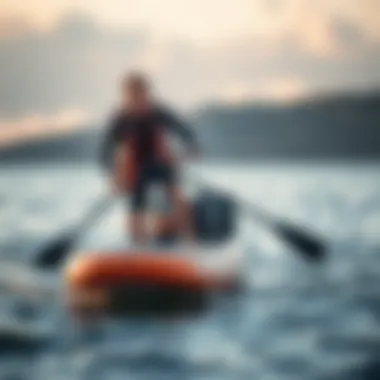
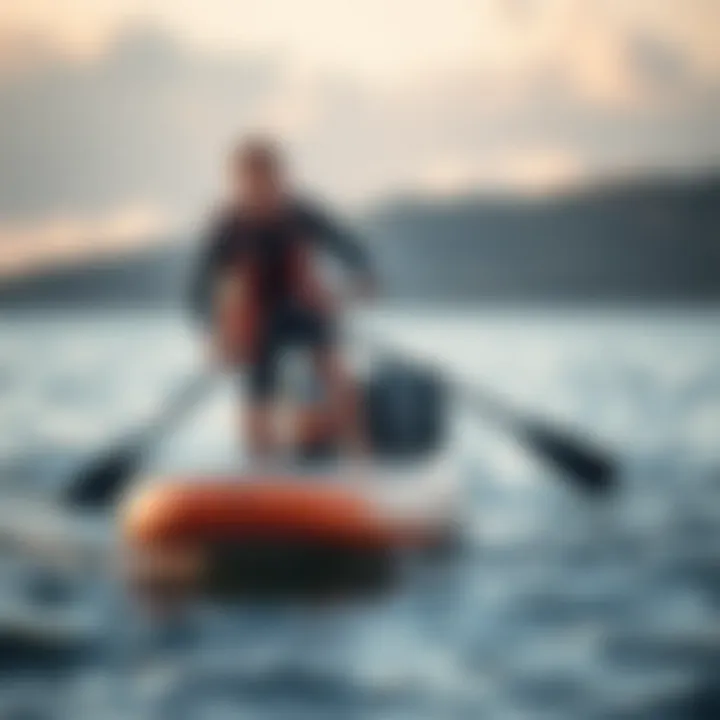
When it comes to motorized paddle boards, the brand and model you choose can make or break your experience on the water. Look into companies that have earned their stripes in the paddle boarding industry. Established brands often provide better customer support and warranty services. Some notable manufacturers to consider include
- Bote Boards: Known for quality craftsmanship and innovative designs.
- Red Paddle Co: Renowned for their inflatable boards that combine portability with performance.
- ePropulsion: Offers electric motors that can easily be fitted to traditional paddle boards.
When assessing specific models, pay attention to their weight capacity, speed, battery life, and user reviews. A board that is too heavy can lead to cumbersome handling, while one with lower weight capacity may not suit all riders. User testimonials can give you a glimpse into the real-world performance and durability of a board, highlighting both positive features and potential drawbacks.
Budgeting for Your Purchase
Budget is often the elephant in the room when planning to purchase a motorized paddle board. These boards can come with a hefty price tag, particularly when you factor in the added components like motors and batteries. Establishing a clear budget before you start shopping can save you time and avoid unnecessary heartache when you stumble upon a model that dazzles yet drains your wallet.
Consider the following when budgeting for your motorized paddle board:
- Initial Costs: This includes the board itself and any accompanying accessories such as paddles, safety gear, or a life vest.
- Maintenance: Some boards require more upkeep than others. Check reviews for information on durability and repair needs.
- Upgrade Costs: Technology is ever-evolving. Factor in the potential need for updated motors or batteries.
"A solid budget can lead to more fruitful choices, allowing for enjoyable adventures without buyer's remorse."
It's advisable to compare prices across different retailers, both online and in-store. Websites like REI and Amazon often have competitive prices and deals. Keeping an eye on seasonal sales can also present opportunities to snag a good deal. Ultimately, spending a bit more upfront for quality can yield years of satisfying water escapades.
User Testimonials and Experiences
User testimonials and experiences offer a vital glimpse into the world of motorized paddle boards. These narratives present real-life accounts from everyday users, adding a layer of authenticity that is often missing in product specifications or marketing materials. It is not merely about endorsements; these stories reveal how motorized paddle boards impact various users, from novices to seasoned enthusiasts.
By tapping into user experiences, potential buyers can gauge the strengths and weaknesses of different models, making informed decisions. Moreover, testimonials can depict the practical applications of the technology involved—highlighting situations where motorized paddle boards excel, as well as instances where they might falter. This sense of realism helps bridge the gap between marketing and actual use.
Beginner Stories
Beginner stories often shine a light on the learning curve associated with motorized paddle boards. Take the case of Maria, a recent college graduate who decided to try out paddle boarding during a family trip to a lake. Initially intimidated by the thought of balancing on the water, she opted for a motorized version, believing it would make her experience more enjoyable and less strenuous.
When she first stepped onto the board, her heart raced, but the gentle hum of the motor quickly calmed her nerves. Maria described the initial glory as "floating on a magic carpet". She appreciated the supplemental power during her first few outings, allowing her to explore areas of the lake that she would not have dared to reach with a traditional paddle board. The experience empowered her to build confidence in her skills while enjoying the scenic beauty. Now, she regularly participates in local paddle board meetups, sharing her journey—one that started with exploring and led to becoming a community member.
Expert Insights
Expert insights delve deeper into the functionality, performance, and user experience associated with motorized paddle boards. Klemen, a professional paddler and outdoor sports coach, has spent years observing the evolution of water sports technology, and he shares valuable perspectives on the shift towards motor assistance. He argues that motorized paddle boards serve not just as alternatives, but as amplifiers of the paddle boarding experience.
In his words, "These boards allow users to tap into the waterways with ease, breaking the barriers associated with distance and fatigue, especially for less experienced paddlers or those with physical limitations." He emphasizes that while some purists may argue against the use of motors, the reality is that these boards can introduce new enthusiasts to the sport, fostering a love that may eventually lead them to try traditional paddle boarding as well.
Klemen notes the importance of balanced moderation:
- Enhancing Skill Development: Using a motor does not stall skill acquisition. Instead, it can allow users to focus on balance and navigation.
- Environmental Awareness: Expert insight often brings attention to sustainable practices in using such technological advancements, ensuring that one enjoys the waterways responsibly.
Incorporating both beginner narratives and professional perspectives provides a well-rounded view of motorized paddle boards, helping readers understand their potential impact on various user categories. This knowledge equips outdoor adventurers with the confidence to explore the possibilities these innovative tools offer for enhancing their aquatic experiences.
The Environmental Impact of Motorized Paddle Boards
Understanding the environmental impact of motorized paddle boards is crucial as the popularity of water sports continues to rise. These boards open doors to countless adventures, but they also raise important questions about sustainability and ecosystem preservation. Balancing enjoyment with environmental responsibility is key for surfers, travelers, outdoor enthusiasts, and fitness professionals alike.
Sustainability Considerations
The production and operation of motorized paddle boards come with their own set of sustainability challenges. Most boards are made from materials such as plastic and foam, which, if not sourced responsibly, can contribute to pollution and environmental degradation. Manufacturers are now investing in eco-friendly materials and production processes.
Key sustainability practices include:
- Sustainable materials: Using recycled materials or bioplastics that reduce reliance on fossil fuels.
- Energy-efficient motors: Developing electric motors that consume less energy and have longer battery lives.
- Waste reduction: Implementing programs to recycle old boards and minimize waste during production.
As consumers, opting for brands that prioritize sustainability can make a significant impact. Supporting companies with transparent supply chains helps foster a more eco-conscious industry. It's about making choices that resonate with the natural world rather than against it.
Ecosystem Effects
Every paddle stroke on the water has the potential to affect local ecosystems. Unlike traditional paddles that generate less noise and disruption, motorized paddle boards can introduce noise pollution and disturb marine life. Species that depend on calm waters, such as certain fish and seabirds, may be particularly sensitive to disturbances.
The introduction of motorized boards into natural habitats can lead to:
- Disturbance of wildlife: Noise and vibration from motors may cause stress to wildlife, impacting their breeding and feeding habits.
- Invasive species: Transporting boards from one body of water to another can unintentionally introduce invasive species, disrupting local ecosystems.
- Water quality impacts: Motors can contribute to water contamination if they leak fuel or other harmful substances.
To mitigate these effects, it is vital for users to take responsibility for their paddle board journeys. Simple practices like ensuring all equipment is clean and operating in designated areas can significantly lessen their environmental footprint.
Protecting our waterways ensures not only a better outdoor experience but also the vitality of ecosystems for future generations.



